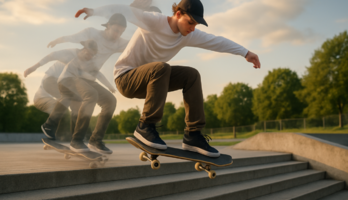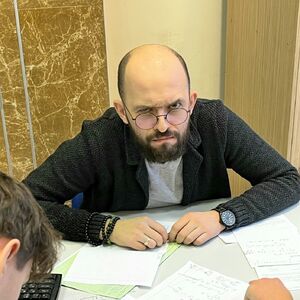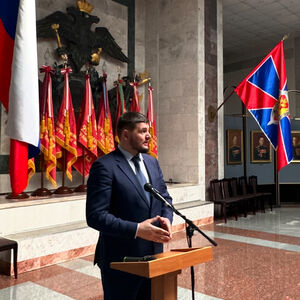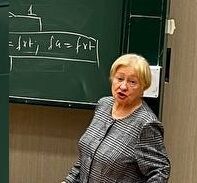42792 (662256), страница 2
Текст из файла (страница 2)
As a result, high-school math courses are largely designed to provide the basics that are needed in such situations and to prepare students for college. Some colleges require all students to take mathematics, but many have math requirements only for students of science, engineering, and advanced planning for business.
Nearly everyone starts learning mathematics before going to school. When television first became popular in the 1950's, some people joked that children were coming to kindergarten already able to count at least as high as the numbers on the channel selector. But the joke turned serious when people realized that very young children really were learning to count from TV, especially if they watched educational shows such as today's "Sesame Street." The tots also learned colors, shapes, and directions—subjects that usually form a large part of the kindergarten mathematics program [7, p. 13].
Mathematics learning is sequential—one idea builds on another. Consequently mathematics is taught in nearly the same sequence in almost every school in the United States [7, p. 29].
In preschool (с 2 till 5 years) the children gain informal practice with counting and shapes. So, one of the first goals of a kindergarten mathematics program is to present numbers and counting in ways that show how words, meanings, and the symbols that represent them are related. The symbols, such as the numerals 1 through 10 are especially important because many children can count correctly before they are able to get any meaning from the symbols [7, p. 14].
They also learn the meaning of words such as top, in, and left. Preschools put much emphasis on games and activities that use simple counting. Reading and writing numerals are almost never taught.
Not all children go to preschool. All of the topics covered at that level are taught again in kindergarten and grade I. The schools cannot assume that all children will have had the same early math experiences.
Today, nearly all children in the United States go to kindergarten (с 5 years). The beginning part of kindergarten focuses on informal experiences similar to those in preschool. Later in the year, more formal experiences start. Sometimes books or kits are used to organize mathematics learning, but many kindergarten teachers believe that it is too early to ask children to work with books or even with specific mathematics materials. Some classrooms may have a computer with math-related software to help teach early math concepts.
Children learn two ways to compare numbers. Thus, even before they learn the order of the numbers, children can understand that some numbers are larger than others and that some numbers are smaller [7, p. 30].
Another important early skill is writing numerals. This skill is essential because it enables children to communicate on paper with their teachers and with others in later life.
Although understanding the meaning of numbers is the main goal of beginning mathematics education, it is not the only goal. There are numerous subgoals. In kindergarten or grade 1, the first subgoal may be to teach such basic concepts as top, left, and before. These ideas have many important uses both inside and outside the classroom. For example, a teacher will lose much time explaining if children do not understand a simple direction such as "Look at the picture at the top of the page."
Another early goal is to teach children to understand patterns. Because mathematics is the study of patterns, the teaching of pattern recognition has become a part of the standard curriculum in kindergarten through grade 3. At first, children are presented with simple patterns to complete. Then they move on to more complex patterns of the same kind.
These exercises are sometimes called attribute studies because such attributes (or characteristics) as being colored or not and being square or not are the focus of attention in addition to the attribute of pattern. Students may use blocks or pictures to do these exercises.
At the same time, students may begin some simple work with geometry. One goal of beginning geometry is to teach children to recognize the most simple shapes—the square, the circle, the triangle, and the rectangle. Teaching such basic terms simplifies classroom explanations and lays the foundation for future work with geometry. Also, some shapes are used when fractions are introduced.
Children respond better to three-dimensional shapes than they do to two-dimensional pictures in books. This probably occurs because, aside from printed materials and television, the shapes around them actually are three-dimensional. Therefore, most educators believe that early experiences with geometry should include such solid shapes as the cube, sphere, cone, cylinder, and pyramid. In fact, the solid figures are often taught first, and the two-dimensional shapes are explained in terms of the solids. A square, for example, is one face of a cube. This "analytic" approach to geometry is usually not tried in kindergarten, but it may be started as early as grade 1.
Another geometric concept that is nearly always taught early is symmetry, specifically what mathematicians call line symmetry. The reason for including symmetry at this level is that it is useful in design. Also, it is not difficult for young children to recognize the difference between symmetrical objects, such as the capital letters A and B, and an asymmetrical object, such as the letter F.
It is clear that for A and B, the dotted line separates two parts that are identical. One part is the reflection of the other. No such line can be drawn for F.
Another goal of early elementary education is to teach children about measurement. This involves many skills and concepts. Often the first notion taught is that a measurement is a number of standard units. It is easiest to explain this idea by measuring straight lines [7, pp. 15-17].
So, а formal kindergarten math program usually starts at least six weeks into the year and often as late as the beginning of the second term. It generally includes counting; ordering and comparing numbers; preparation for addition and subtraction; comparing size: preparation for telling time; the concept of a penny; recognizing squares, triangles, and circles; such concepts as top, bottom, front, back. in. on, between, left, and right (which are needed to explain lessons); classifying objects; and recognizing patterns. Most time is spent on counting and learning to understand numbers through one-to-one matching and comparing and ordering numbers.
Every grade has a major goal for mathematics achievement, although it is not always formally defined. Thus, for kindergarten, the major goal is counting [7, p. 31].
III. THE METHODS OF CHILD’S ACQUAINTANCE WITH GEOMETRIC SHAPES
Preschoolers' intuitive knowledge of geometry frequently exceeds their numerical skills. By building on strengths and interests that are already present, you can foster enthusiasm for math and provide a logical context to develop number ideas.
By age six, children often have stable yet limiting ideas about shapes. Four-year-old Tina tells her mother, "That's not a square. It's too big. A square looks like this." Her friend Charlie adds, "Triangles have to be this way. That's not a triangle. It's too upside down." Broaden child's understanding by pointing out a variety of examples — squares that are many sizes and triangles that are "long," "skinny," "fat," and turned in many directions. You can also encourage deeper thinking about shapes not just through hands-on activities and discussions, but through picture books such as The Greedy Triangle by Marilyn Burns [1, pp. 5-6].
Geometry is the study of shapes, both flat and three dimensional, and their relationships in space. Geometry enters infants' lives from birth as they attempt to make sense of the shapes in their environment: crib bars, stuffed animals, mother's breast and face, the door to the bedroom. Geometric shapes become some of the first intentional scribbles made in young children's drawings, and they delight in their awareness of the shapes around them.
Such natural interest deserves encouragement and informal teaching intervention. In the 1950s, two Dutch educators developed a theory of stage development in geometric understanding. The van Hiele theory has gained acceptance in the United States in recent years, and applies to children from the early years through high school. An important tenet of the theory is that children do not grow through the stages automatically but, with teacher assistance, will do so competently (Teppo, 1991). What children are exposed to in the early years sets the stage for learning in geometry throughout their entire school experience. Through the primary grades, children are at the earliest, visual, stage in which they explore their environment to learn to identify the shapes within it. Activities such as describing, modeling, drawing, and classifying help them develop a spatial sense [6, p. 457 ].
Douglas H. Clements offers such reception for formation of knowledge of children about shapes. In a preschool classroom you might see a scene like this: A teacher challenges Michelle and Debbie to use their bodies to make a shape together. The girls sit down facing each other and stretch their legs apart. With feet touching, they create a diamond. Another child takes a look, sees the diamond shape, and says: "If we put someone inside, we can make two triangles." Immediately, they ask Ray to scrunch in and lie across the middle.
It works. A diamond can be divided into two triangles. Michelle notes that there's a shape that has six sides, and she wants to try making one of those. Another child may even know that the shape is called a hexagon. After a brief discussion, Michelle gets five other children together. Then, under her direction, they all lie down on the floor and create a six-sided shape [1, p. 5].
Ellen Booth Church ( a former professor of early childhood ) suggests parents to apply following receptions in the course of acquaintance of children with shapes:
-
Sort the house: Collect a variety of household objects, like bottle caps and envelopes, and invite your child to sort them into different piles — one for circles, rectangles, and so on. Invite her to go on a treasure hunt around the house to find "one more thing" for each pile.
-
Cut shape sandwiches: Use cookie cutters to make dainty tea sandwiches for a Shape Tea Party! Cut the bread with the cutters, then spread the shapes with cream cheese. Try filling the bread slices with foods of different shapes, like a round tomato slice on square bread or a triangle of cheese on round bread.
-
Make puzzles: Use large, colored file cards, folders, or poster board to make shape puzzles together. Cut out big basic shapes, like circles or triangles, and then cut each into two or three pieces. Your child can decorate the shape puzzles with crayons and then put the puzzles back together.
-
Explore letters: Hunt for shapes within the letters of the alphabet. Write out the alphabet in capital letters, and have your child find which shapes make up each. You can also show her how shapes form as you write; invite her to experiment by drawing large shapes of her own and turning them into letters.
-
Paste a picture: Provide your child with paste and a variety of cut-out paper shapes in different sizes and colors for creating pictures. Encourage him to combine shapes to create designs or familiar images. For example, he might make a shape person with a circle head, a square body, and rectangle legs.
-
Search through stories: Many children's picture book author-illustrators boldly use basic shapes in their illustrations (books by Tana Hoban, Eric Carle, and Leo Lionni are particularly good places to start). As you read with your child, ask her to point out the shapes she finds in each picture.
-
Take a walk: Move shape play outside by taking a walk with cardboard cut-outs of a triangle, circle, square, and rectangle. Your child can match them to objects like signs, plants, doors, and car tires. Take along your digital camera to snap photos of the shapes. Then print them and make a family shape book [2, p. 12].
Ellen Booth Church considers that boxes are the raw materials of creative thinking. Exercises: «Big and Little Sorting», «Boxes and Lids Matching», «Serial Boxes», « Fill 'Em Up», «Make a Shape Feely-Box», «Treasure Boxes», «Shadow Box Collages», «Play Store», «You-in-the-Box» and others [3, pp. 9-10].
Also Ellen Booth Church offers to use snacks and mealtime to teach big ideas with taste and ease. The kitchen is filled with many wonderful foods and cooking tools in a variety of colors, sizes, and shapes. It is the perfect laboratory for exploring some of the first topics children learn in school: color, shape, and size. Understanding these concepts is important because your child uses them in observing, comparing, and discussing all she sees and encounters. The ability to notice, use, and voice similarities and differences are at the heart of beginning math, science, and reading skills. For example, reception for acquaintance with the shape. Eat a square meal. We have all heard of the importance of eating a square meal of healthy foods, but why not have a really "square" meal? Serve waffles (big and little squares) with a side dish of pineapple chunks for breakfast. Have a snack of square cheese slices on square crackers placed on a square napkin. As you are preparing and enjoying your meals, ask your child to notice the similarities and differences between the different squares. Help her notice that all the squares have four sides, but can be various sizes. For a fun challenge, give your child a slice of pre-wrapped American cheese. As she unwraps it, ask her how she can fold her cheese square into a triangle (point to point). One way to focus on a particular color is to have a meal all in the same color. This will help your child to not only focus on learning the name of a particular color, but also it will help her see the many different shades of a particular color. For example, not all oranges are the exact same shade and so on [4, p. 3].
Julie Sarama, PhD, and Douglas H. Clements, PhD offer are some activities parents can try at home to support math learning:
















